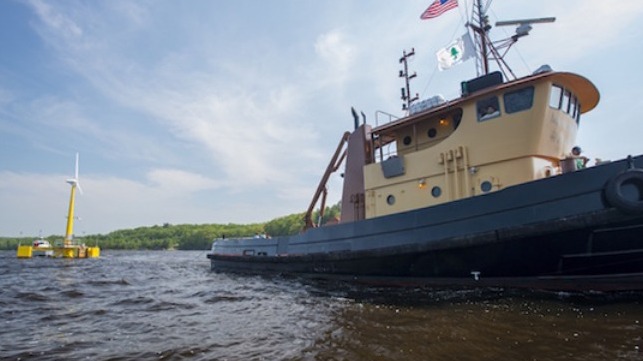First Jones Act Ruling as it Applies to Offshore Wind Sector

A first-of-its-kind ruling on the Jones Act and its application to a floating offshore wind project was released on August 23, 2021, by U.S. Customs and Border Protection. Last year, the U.S. confirmed that it planned to apply the Jones Act to the offshore wind industry in a fashion similar to how it has been historically applied to the offshore oil and gas sector. While the cabotage rules require the use of U.S. and coastwise certified vessels, the ruling is likely the first of many instances where questions will arise on specific situations.
“The ruling approved the mixed use of U.S. and foreign barges together with U.S. coastwise qualified tugs to transport and position a floating offshore wind turbine off the coast of Maine,” writes Charlie Papavizas, a partner in the law firm Winston & Strawn that represents the New England Aqua Ventus project. “Because the foreign launch barges would not be engaged at any point in “transportation,” CBP approved both methods as being in accord with the Jones Act.”
The law firm has requested a decision from CBP as to elements of the Jones Act and coastwise Towing Statue as it would apply to the construction and positioning of a demonstration unit being built by the project in Maine. Aqua Ventus, a joint venture between Diamond Offshore Wind and RWE Renewables, is working with the University of Maine to construct a floating offshore wind demonstration unit. The purpose of the demonstration project is to further evaluate the floating technology, monitor environmental factors and develop best practices for offshore wind to coexist with traditional marine activities. A small-scale pilot has been tested, and now the project is seeking to construct by 2023 a floating semisubmersible hull that would mount an 11MW wind turbine.
The project plan calls for building and assembling the hull onshore in Maine and then transporting it to a site within the U.S. territorial waters near Monhegan Island, Maine. Once in position, the hull would be submerged and anchored to the seabed.
Requesting a determination of the Jones Act as it applied to the project, the law firm proposed several alternative construction and installation scenarios. They ranged from lashing together barges that are non-coastwise-qualified as a base during the fabrication in port or as a launching platform. In one scenario, they say the barges might have to be moved from the dock to make space for other vessels but would return to the same dock. In all the scenarios they would also be using coastwise-qualified barges in parts of the operation and always be using coastwise-qualified tugs.
According to the ruling letter released by CBP, the first element of the decision hinged on the question if the materials being moved are “merchandise,” as the Jones Act specifically prohibits the coastwise transportation of “merchandise” on non-coastwise qualified vessels. CBP ruled that the hull being fabricated would qualify as merchandise.

that matters most
Get the latest maritime news delivered to your inbox daily.
Because the barges would be used as a platform and not transportation, CBP said that the proposed scenarios do not violate the Jones Act. CBP would permit the barges to move away from the dock to make space available as long as the barges returned to the same port. Further, since all towing will be conducted by coastwise-qualified tugs it is not a violation of the Towing Statue.
While it was a narrow ruling on one specific case, it still represents the first decision related to the emerging offshore wind sector. CBP did not qualify if its ruling was at all impacted by the fact that this is a demonstration project as opposed to a commercial installation.
